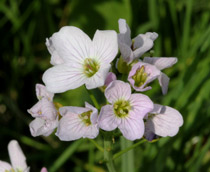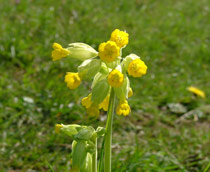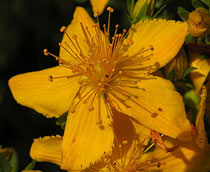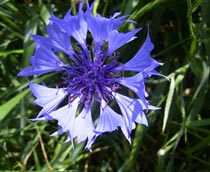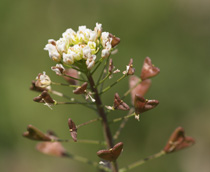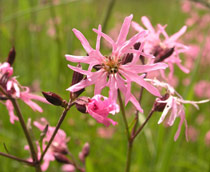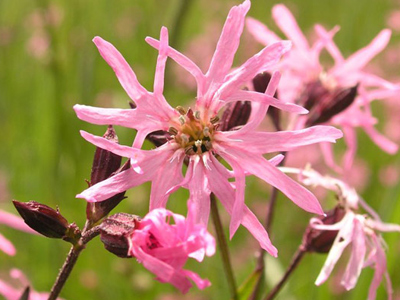
The stems on this wildflower have downward-pointing barbed hairs which make the plant rough to the touch.
Plants - Wildflowers 2
The body of a living plant contains 50-98 percent of water. The plant gets practically all its water from the soil. The roots act as a pumping device, and the root hairs are the most active in this absorption process. The following quiz is our second on wildflower plants of Britain. See how many of them you know.
You may click on the photos to enlarge them.
To see a larger image, click on the picture.
1 .
Can you name this wildflower?
Lady's Smock
Wild Mustard
Coltsfoot
Heather
- Order: Brassicales
- Family: Brassicaceae
- Genus: Cardamine
- Species: C. pratensis
- This plant is also knows as the Cuckoo Flower
- Balls of froth can be seen on the stems; these are formed by larvae of the meadow froghopper.
- Flowers are rich in nectar and the content of vitamin C in the leaves is five times higher than in lemons!
2 .
Can you name this wildflower?
Yarrow
Cowslip
Toadflax
Harebell
- Order: Ericales
- Family: Primulaceae
- Genus: Primula
- Species: P. veris
- Commonly found in pastures and on grassy slopes.
- Also knowns as Paigle, Herb Peter and Fairy Cups.
- Produces two types of flowers on separate plants.
- Its leaves are used as a salad green in Spanish cuisine.
3 .
Can you name this wildflower?
Water Forget-me-not
Ox-eye Daisy
Mouse-ear Hawkweed
Greaty Hairy Willow-herb
- Order: Asterales
- Family: Asteraceae
- Genus: Pilosella
- Species: P. officinarum
- Grows in dry sandy soils, dry limestone pastures and heathland.
- Often grows as a pioneer in sandy or chalky areas, where other plants cannot exist.
- One of the most common species of its kind.
4 .
Can you name this wildflower?
St John's wort
Sheep's Sorrel
Birdsfoot-trefoil
Spurge
- Order: Malpighiales
- Family: Hypericaceae
- Genus: Hypericum
- Species: H. perforatum
- The flowers are yellow but, when rubbed, the crushed cells release colouring matter which turns red in the air.
- In the past, stories about its bewitching powers were rife because when a cow had eaten a large quantity, its milk turned pinkish!
5 .
Can you name this wildflower?
Cornflower
Kingcup
Germander Speedwell
Sweep's Brush
- Order: Asterales
- Family: Asteraceae
- Genus: Centaurea
- Species: C. cyanus
- Became widespread in pre-historic Europe.
- Flowers contain a beautiful blue dye based upon the pigment cyanin.
- Cyanin is soluble in water and is used to colour perfumes, wool, aromatic spices and even Champagne wines!
6 .
Can you name this wildflower?
Meadow Vetchling
Ragged Robin
Toadflax
Field Bindweed
- Order: Solanales
- Family: Convolvulaceae
- Genus: Convolvulus
- Species: C. arvensis
- A very invasive and troublesome weed, with the most delightful flowers.
- Grows in abundance on wasteland, banks, roadsides and in ditches.
- Does not need fertile soil and can withstand drought.
7 .
Can you name this wildflower?
Cowslip
Shepherd's Purse
Harebell
Wood Anemone
- Order: Brassicales
- Family: Brassicaceae
- Genus: Capsella
- Species: C. bursa-pastoris
- Very hardy and is capable of flowering in the depths of winter.
- Has long been used in folk medicine to stop internal bleeding as it contains a substance which causes contraction of blood vessels.
8 .
Can you name this wildflower?
Aaron's Rod
Yarrow
Bladder Campion
Ground Elder
- Order: Caryophyllales
- Family: Caryophyllaceae
- Genus: Silene
- Species: S. vulgaris
- The most striking feature of this plant is its inflated calyx.
- The depth of the calyx means only nocturnal moths with a long proboscis are able to reach the nectar.
- Grows on dry slopes, roadsides, quarries and banks.
9 .
Can you name this wildflower?
Scarlet Pimpernel
Shepherd's Purse
Dwarf Mallow
Ragged Robin
- Order: Caryophyllales
- Family: Caryophyllaceae
- Genus: Lychnis
- Species: L. flos-cuculi
- Inhabits mainly damp woods, meadows and marshy ground.
- The nectar producing flowers can be pollinated by insects with a short proboscis.
- The stems have downward-pointing barbed hairs which make the plant rough to the touch.
10 .
Can you name this wildflower?
Wild Mustard
Ox-eye Daisy
Dwarf Mallow
Bladder Campion
- Order: Brassicales
- Family: Brassicaceae
- Also known as Charlock
- A widespread, persistent, annual field weed.
- The seeds retail their viability for years.
- Seeds also provide lubricating oil.
- This nectar producing plant is often frequented by bees.
**Unlimited Quizzes Await You! 🚀**
Hey there, quiz champ! 🌟 You've already tackled today's free questions.
Ready for more?
Ready for more?
🔓 Unlock UNLIMITED Quizzes and challenge yourself every day. But that's
not all...
not all...
🔥 As a Subscriber you can join our thrilling "Daily Streak" against other
quizzers. Try to win a coveted spot on our Hall of Fame Page.
quizzers. Try to win a coveted spot on our Hall of Fame Page.
Don't miss out! Join us now and keep the fun rolling. 🎉
**Unlimited Quizzes Await You! 🚀**
Hey there, quiz champ! 🌟 You've already tackled today's free questions. Ready for more?
🔓 Unlock UNLIMITED Quizzes and challenge yourself every day. But that's not all...
🔥 As a Subscriber you can join our thrilling "Daily Streak" against other quizzers. Try to win a coveted spot on our Hall of Fame Page.
Don't miss out! Join us now and keep the fun rolling. 🎉





